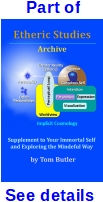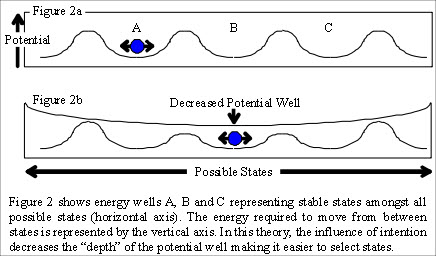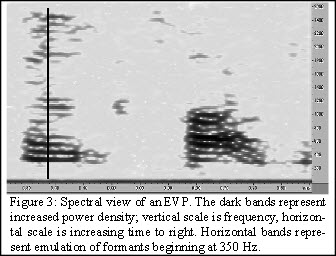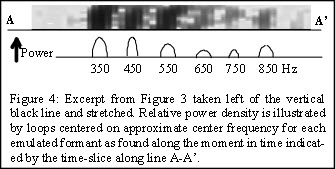Abstract
 In the article, The Formation of EVP (Summer 2009), three techniques for the formation of Electronic Voice Phenomena (EVP) were discussed: Transform, EVPmaker and speech synthesis stimulated with detection of changes in environmental energy. This article provides an informed speculation as to the physical processes that might be involved in voice formation using these techniques.
In the article, The Formation of EVP (Summer 2009), three techniques for the formation of Electronic Voice Phenomena (EVP) were discussed: Transform, EVPmaker and speech synthesis stimulated with detection of changes in environmental energy. This article provides an informed speculation as to the physical processes that might be involved in voice formation using these techniques.
Scope
Trans-etheric influences sometimes share characteristics. For instance, EVP and visual forms of the phenomena appear to depend on the same physical processes, while apports seem to depend on other processes. Moving, interactive orbs seem to use even different processes. Understanding the physical processes involved in the manifestation of such phenomena may help the understanding of what is occurring on the other side of the veil. The following theory is specific to EVP but may be applicable to other phenomena, depending on future research.
Theory
In EVP, the voice is seen to be formed from available audio-frequency energy.1 In simple terms, this is just noise; however, some noise works better and most experimental recording devices are really noise conditioners intended to improve the Quantity and Quality (QQ) of the recorded utterances. The most optimum noise appears to be broad-spectrum audio containing many voice-frequencies and providing numerous optional stable states.
Stable States
 Figure 1 illustrates a chaotic system; in this case, an object orbiting a planet. It has been noted that a system tends to be more stable when it is not restricted to a single state. For instance, it has been reported that, “the rhythms of a healthy heart are chaotic.”(2 ) By “numerous stable states,” a system such as the orbiting object in Figure 1 is intended. The object is able to occupy different orbital paths and remain in a stable orbit. The three paths illustrated in Figure 1c are stable and tend toward the orbit illustrated in Figure 1a. In terms of chaos theory, the “norm” of the orbits would represent the “attractor” toward which all stable variations of the orbit are drawn. An orbit outside of the influence of the attractor would tend to be unstable and the object would be expected to “leave orbit.”
Figure 1 illustrates a chaotic system; in this case, an object orbiting a planet. It has been noted that a system tends to be more stable when it is not restricted to a single state. For instance, it has been reported that, “the rhythms of a healthy heart are chaotic.”(2 ) By “numerous stable states,” a system such as the orbiting object in Figure 1 is intended. The object is able to occupy different orbital paths and remain in a stable orbit. The three paths illustrated in Figure 1c are stable and tend toward the orbit illustrated in Figure 1a. In terms of chaos theory, the “norm” of the orbits would represent the “attractor” toward which all stable variations of the orbit are drawn. An orbit outside of the influence of the attractor would tend to be unstable and the object would be expected to “leave orbit.”
Potential Wells
Figure 2 illustrates the concept of potential wells. The horizontal axis indicates possible states of a system and the vertical axis represents the energy required to change states (potential). The wavy line indicates the relative potential required to change states. This can be referred to as a series of potential wells, for which locations A, B and C represent troughs. The small circle represents the selected state and the illustration indicates that it requires more energy to move out of a trough, but once in the next trough, the selection is once again relatively stable. This illustrates the concept of optional stable states.

Intention Decreases Potential Well
Figure 2b is the same as 2a, except that the potential energy required to change states decreases toward potential well B, making it easier to select relative to A and C.
According to this theory, the influence of intention as expressed by a personality is able to reduce the amount of energy required to change the state of a system, thereby causing the system to assume a desired state. The concept is thought to apply to physical energy in general, and should not be specific just to ITC. A common physical factor is permittivity (symbolized by the Greek letter epsilon), which is a measure of how easily an electric field affects a material; however, other possibilities should be considered, for instance a literal interpretation of an attractor in chaos theory may be more appropriate.

Figure 3 is a spectral display of an EVP. The horizontal axis is time increasing to the right and the vertical axis is frequency increasing toward the top. The bright horizontal bands are caused by the anomalous voice and represent increased energy associated with emulated formants. Here, it is important to understand that the voice is not formed by a physical organism. Formants are frequency groups formed in the mouth based on sounds generated by the vocal cords. Their relationship, intensity and duration collectively produce a voice. In EVP, available frequencies appear to be selected and given more power to emulate voice. The vertical black line in Figure 3 represents a “time slice.” The emulated voice is created moment-by-moment. Figure 4 shows a segment of the spectrogram in Figure 3 taken to the left of the black line and up to about 1,000 Hz and rotated 90 degrees. The line below it illustrates increases in energy associated with the emulated formants as encountered along time-slice A-A’. In this theory, this sample represents many such samples over time to produce the phenomenal voice.
Stochastic Resonance
 A weak signal can be amplified by higher amplitude noise via the process known as stochastic resonance. A common characteristic for both visual and audio forms of ITC is the presence of noise and the formation of audio or visual features in the noise. In the video-loop technique, order naturally emerges in the optical noise as small areas of about the same intensity. It is in these areas of order that features are sometimes found. The indication is that information is being impressed on these small perturbations acting as “seed energy” which evolve into the areas of order. In audio-loops, the signal tends to “go to” saturation too quickly to permit the natural emergence of order to be recognized.
A weak signal can be amplified by higher amplitude noise via the process known as stochastic resonance. A common characteristic for both visual and audio forms of ITC is the presence of noise and the formation of audio or visual features in the noise. In the video-loop technique, order naturally emerges in the optical noise as small areas of about the same intensity. It is in these areas of order that features are sometimes found. The indication is that information is being impressed on these small perturbations acting as “seed energy” which evolve into the areas of order. In audio-loops, the signal tends to “go to” saturation too quickly to permit the natural emergence of order to be recognized.
Hypothesis
A trans-etheric influence is initiated by an etheric personality as a subtle-energy expression of intention that acts on physical processes to select required energy states to form a desired effect.
Applicability
To determine applicability of this hypothesis, it is important to remember that there is necessarily an etheric-to-physical interface; that something like intention represents the etheric form of the influence and some fundamental physical characteristic must be the physical form of the influence. As with the audio signal represented in Figure 4, the influence must be considered as a moment-to-moment application of influence to produce a general result. An economical solution requiring a minimum amount of energy should be expected.
In EVP, it is speculated that a specific component in an electronic circuit is used to inject the information. The component is most likely one with an active region, such as a transistor junction or the inter-element region of a vacuum tube. It is also likely that a plasma field is more susceptible to influence; something common to both transistors and vacuum tubes.
This hypothesis may apply to all forms of trans-etheric influence. Clearly visual and audio forms of ITC involve transformation of energy into anomalous features. Less obvious is whether or not this hypothesis applies to psi functioning. The question must be asked and tested as to if the action of intention can be seen to change the energetic environment of portions of the brain to intelligently produce information. Likewise, can audible phenomena such as direct voice be caused in this way? Can gravity be so influenced as to cause levitation?
Testing The Hypothesis
The key to this hypothesis is ease of selecting energy states. In EVP, using naturally occurring noise such as that produced by a fan should produce higher QQ of EVP than using noise generated by a technology that produces many frequencies of similar amplitude. Ideally, the noise will have multiple instances of each frequency of different amplitudes so that the most useful one can be selected. This can be tested.
Optical energy would be best for visual phenomena if it is very chaotic. In EVP formed via random processes, such as seen in EVPmaker,3 the random process that has the most chaotic distribution of signal noise should be the most effective for EVP.
Unstable circumstances should be expected in haunting phenomena. Changes in noise or environmental energy are likely “carriers” for trans-etheric influences in much the same way that chaotic noise appears best for EVP.
References
- Gullà, Daniele, Computer–Based Analysis of Supposed Paranormal Voice, ATransC, atransc.org/journal/gulla-voice_analysis.htm, Reviewed November 2012.
- May, Robert, The Chaotic Rhythms of Life, New Scientist, November 18, 1989 (Read in Google Books) Reviewed November 2012.
- Bion, Stephan, EVPmaker, tonbandstimmen.de/evpmaker/index_e.htm , Reviewed November 2012.
![]()
